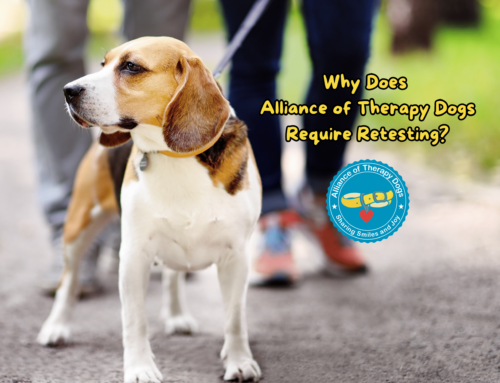Some of the most unsung heroes in our world are animals. Therapy animals provide their human friends with multiple benefits at all kinds of facilities — schools, nursing homes, hospitals, etc. After tragedies such as natural disasters and school shootings, a therapy animal is there to comfort children as well as adults who have been traumatized. They are not just regular household pets, and their relationships with patients are beneficial to both them and humans. The most common therapy pets are dogs and cats, but they are not the only medical professionals you can work with — there are therapy llamas, pigs, and even birds! In this article, we will focus on all the things you need to know about therapy dogs specifically.
The Difference Between Therapy Dogs and Service Dogs
Many people use the terms “therapy animal” and “service animal” interchangeably, but they are two completely different things. The official website for the Americans with Disabilities Act (ADA) states, “service animals are defined as dogs that are individually trained to do work or perform tasks for people with disabilities. Examples of such work or tasks include guiding people who are blind, alerting people who are deaf, pulling a wheelchair, alerting and protecting a person who is having a seizure, reminding a person with mental illness to take prescribed medications, calming a person with Post Traumatic Stress Disorder (PTSD) during an anxiety attack, or performing other duties. Service animals are working animals, not pets. The work or task a dog has been trained to provide must be directly related to the person’s disability. Dogs whose sole function is to provide comfort or emotional support do not qualify as service animals under the ADA.”
Unlike service animals, therapy animals are not supported under the ADA, meaning that they may not be allowed at certain public venues or in living situations in which the landlord has a no-animal policy. Therapy dogs are trained but not as rigorously or for the same tasks as service dogs. Their main responsibilities are to provide psychological and physiological therapy to people other than their handlers in times of stress. They have good temperaments and calm, easy-going personalities. Whereas service dogs are not supposed to interact with or be touched by anyone but their handler, patients are encouraged to interact with therapy dogs while they are on-duty.
The Duties of Therapy Dogs
Dogs make such effective therapy animals because of their sensitivities to human emotion. They have been proven time and time again to show sympathy and empathy by nuzzling or whining when they sense a human is sad or in general emotional distress. Therapy dogs often visit places with vulnerable populations of people such as nursing homes, hospitals, and college campuses to soothe stressed patients and students. Therapy dogs are even being brought into the corporate workplace, where they make employees feel less stressed and more productive. Their roles vary from actively participating in physical rehabilitation therapy to giving children with learning disabilities the confidence to read aloud and improve reading skills. Some work exclusively in one field, such as one particular campus or building.
Therapy dogs can come in all breeds, shapes, and sizes, and they all share a common purpose — to provide physically- and mentally disabled people with comfort and companionship. They play a key role in recovery and stress management because of their non-judgmental natures and willingness to interact with people no matter their physical or emotional states. However, not every dog is meant to be for therapy dog certification. Therapy dogs must enjoy meeting people of all ages and comfortable with being touched anywhere on their bodies, including their ears and tail. They must know basic obedience, such as walking on a leash, sitting, and staying, and cannot be bothered by sudden movements and hovering or loud sounds like crying and yelling. When a therapy dog is in the room, you can pet it, play with it, let it sit in your lap, simply look at it–whatever makes you feel comfortable and less stressed.
The Value of Therapy Dogs
Just the presence of a therapy dog will help take a person’s mind off of all their worries, physical or emotional pains, and anxieties. The simple act of petting a dog has been proven to provide a human with multiple mental and physical health benefits. When human pets and animals, hormones such as serotonin, prolactin, and oxytocin, which play a role in elevating moods, are released in the brain. Animal-assisted therapy also lowers anxiety to help patients relax, provides comfort, reduces loneliness, increases mental stimulation, and provides an escape or happy distraction. Physically, the presence of and interaction with therapy animals can help lower blood pressure, reduce the number of medications that people need, diminish overall physical discomfort or pain, motivate people to exercise, and help children with autism in the departments of language and social interaction.
It’s no wonder that you can walk onto a college campus during finals week and witness students playing with the university’s therapy dog to relieve stress or into a bustling hospital where a dog is roaming from room to room making sure the patients are comfortable. Their presence and unconditional love are therapeutic, calming, and mood-boosting. To learn more about the joy-spreading abilities of therapy dogs, join the Alliance of Therapy Dogs, or browse the website!






